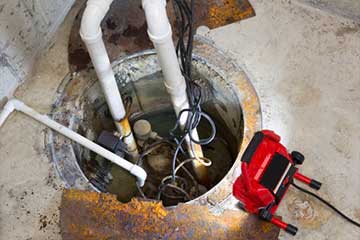
The pit where the sump pump sits in should have a little bit of water in it at all times – that’s very normal. But, if there is too much water, well that is a sign that there’s a problem.
If there is water and the sump pump is running – that’s a good sign but if it’s not running and there’s too much water in the pit – then it’s time to find out what the problem is and fix it.
Click here for a Sump Pump Maintenance Checklist.
What Is A Sump Pump?
If you have never seen a sump pump, you may be imagining that it is a very large piece of machinery, like a big generator. But the truth is, they are around 2 feet in height and less than that in width. They are often buried in a hole (aka pit) in the basement or crawlspace floor. The chosen location should be the lowest part of the surrounding space.
A typical pit is about 30 inches deep and about 24 inches across. About the size of a 5 gallon bucket. So, it’s not a large intrusion in your home environment.
A second type of sump pump is a pedestal pump. This type sits on top of the pit (instead of inside the pit). It’s less expensive to install BUT it’s also louder when it’s running.
A sump pump begins to work when it detects water under the floor surface. The water flows into the pit which then triggers the sump pump to turn on and it’s job then is to re-direct the water away from the building.
Sump pumps are often (but not necessarily) powered by electricity. The ones that do use a standard household current so there’s no special wiring that needs to be installed.
Pumps that don’t use electricity are called “water pumps”. These units use your home’s water pressure – no batteries or electricity needed. It can work independently or with an electric sump pump. Most homeowners use a water pump as a backup unit.
The purpose of a sump pump is to help to prevent flooding in a lower level floor like a basement. They are an essential piece of equipment if the foundation of the home sits below the water table. Sump pumps pull water away from the house and depending on your property, either disperses it or dumps it into a well or municipal storm drain.
What Does A Sump Pump Do?
The purpose of a sump pump is to help to prevent flooding in a lower level floor like a basement. They are an essential piece of equipment especially if the foundation of the home sits below the water table.
How Does Water Get Into The Sump Pump?
You may wonder how does the water get into the sump pump pit in the first place?
The water generally comes into the pit through a the soil and/or a series of drains in the foundation of the building. Since the purpose of the sump pump is to pull water away from the building so that the basement / crawlspace remain dry – it makes sense that the water has to go somewhere.
The sump pump then pushes that water away from the building – helping to keep everything dry.
If you have any questions about your sump pump or are having problems with it, call Atlantis Plumbing today at 770-505-8570. We are available 24 hours a day, 7 days a week.